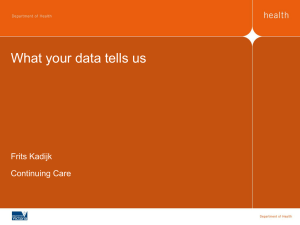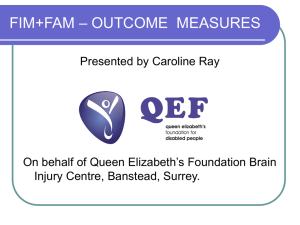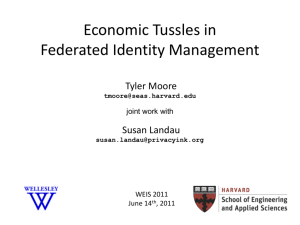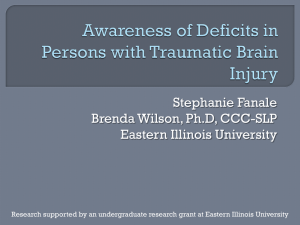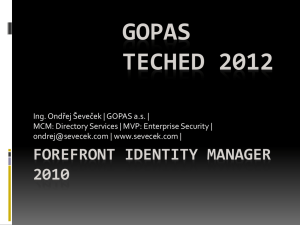VCH & eduGAIN, Frank Vercoulen - Eindhoven Technical
advertisement
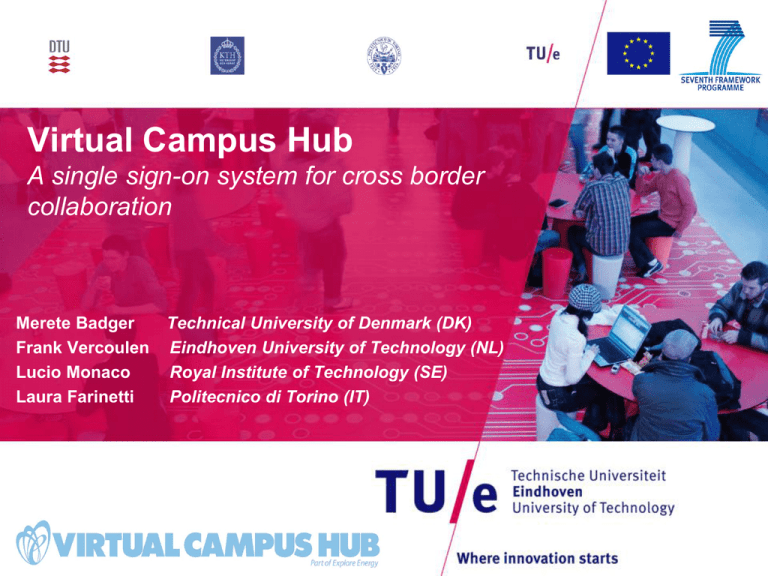
Virtual Campus Hub A single sign-on system for cross border collaboration Merete Badger Frank Vercoulen Lucio Monaco Laura Farinetti Technical University of Denmark (DK) Eindhoven University of Technology (NL) Royal Institute of Technology (SE) Politecnico di Torino (IT) 1 Partners in Virtual Campus Hub Components of Virtual Campus Hub 1. Inventory of the most important ICT barriers for international collaboration in education. 2. Demo platform to prove that some of these barriers can be removed: Easy access to partners’ applications (FIM) More efficient and more flexible setup of online activities or online participation in regular activities (UC hub) Easier collaboration with industry (non-HE IdPs) 3. Vision on how to apply these insights and experiences in concrete collaboration initiatives (e.g. international joint programs) Concept: virtual education portal for joint programs Demo portal (proof of concept) Functionality: • Access with your own account to partners’ applications • Create international groups (virtual organizations) • Single sign-on access through simple website (https://vch.tue.nl) 12-06-2013 IdPs connected to VCH 04-10-2012 6 Access to learning materials: Post educational course on wind energy (DTU) Course materials and interaction through LMS (itslearning as a cloud service provider) 12-06-2013 Access to learning materials: Remote laboratory (KTH) The remote laboratory is operated and monitored on-distance for real-time experiments and collection of measurement data. Experimental Setup Network Camera Remote laboratory exercises (KTH) WWW Control and monitoring of the experiment Exp. Control Web Server More info: http://www.energy.kth.se/proj/projects/Remote_labs/RL/RL_website/RCL/RCL.html Collaboration environment (TU/e) • Share and collaborate on documents (Sharepoint) • Efficient and reliable setup of online activities (unified communications, together with SURFnet) (fully online or with online participation of some) • Remote lectures • Joint meetings and events • Supervision of student projects and consultation of experts 12-06-2013 9 Enabling international collaboration: National (NRENs) and European (Géant) 12-06-2013 Technological components Federated authentication Use your own institution’s account for applications elsewhere Group management Using cross-institutional and cross border group definitions (virtual organizations) for authorization at different locations and in different applications In this project: SURFteams (part of SURFconext, based on Grouper from Internet2). Also available as open source (Openconext, http://www.openconext.org). No general standard across NRENs available yet. 12-06-2013 11 Results • Connections realized for several identity providers (IdPs) and applications (SPs). • Cloud service (DTU itslearning) connected to VCH • Scalability of concept shown (by adding extra IdPs) • Knowledge and experience with respect to using GéanteduGAIN 12-06-2013 12 Experiences • FIM is promising technology and fairly well standardized across NRENs (except for group management) • Enables institutions to join forces in education • Knowledge and motivation at local institutions still very limited • Crossing borders (inter-federation) is also new to NRENs • Difficult to sell infrastructure improvements to users • Not allowing industry on Géant infrastructure as IdP hampers collaboration with industry • Involve federations and central IT departments from the start! • UC hub technology in earlier stage of development than federated logon: few standards available (yet) and companies not very eager to connect to FIM infrastructure (yet?) 12-06-2013 13 Potential of the Virtual Campus Hub concept Can be re-used and up-scaled: • Other countries and institutions • Other collaborative programs • Other disciplines Acknowledgements Virtual Campus Hub is partially funded by the European Commission under the 7th Framework Programme National federations are involved in Virtual Campus Hub International e-Infrastrucure forms the backbone of the Virtual Campus Hub technology Cloud service provider connected to Virtual Campus Hub Where should it go from here? 1. Towards institutions knowing about (cross border) FIM 2. Towards institutions wanting (cross border) FIM 3. Towards institutions preparing properly for (cross border) FIM projects 4. Towards (cross border) FIM as a utility service 5. Towards federations as knowledge brokers for institutions 6. Towards federations accepting reality 04-10-2012 16 Towards institutions knowing about (cross border) FIM • People that decide on or initiate collaborations mostly don’t know that FIM exists and could be useful. More marketing efforts by federations might help. 04-10-2012 17 Towards institutions wanting (cross border) FIM • For people to understand FIM’s usefulness, you need a perspective for the future: what’s next and where will it lead us? (cross border) FIM as a growth path • Beyond “federated logon only”: group management, ID-mapping, presence, calendaring… what functionalities are needed for which purposes and how do they fit the bigger picture? • What functionalities are federations likely to pick up and what is left to others? 04-10-2012 18 Towards institutions preparing properly for (cross border) FIM projects • Involving all relevant stakeholders (both federations and internal stakeholders) from the start (i.e. while writing the proposal) would help a lot • Analyze the architecture needed to open up the internally focused ICT infrastructure to the outside world (as R&E processes using it have done a long time ago) 04-10-2012 19 Towards (cross border) FIM as a utility service • Black box for institutions • Better standardization / attuning of technology involved in interfederation (e.g. group management) • A general solution for guest accounts could be useful (via eduGAIN?) • Coordination of (inter)federation work by federations themselves • Federations as (technical and legal) brokers for (cross border) cloud services? 04-10-2012 20 Towards federations as knowledge brokers for institutions • Institutions have little knowlegde: they need to know who to ask (about technical and legal issues) • Federations could assist institutions in working out the right architecture for (international) collaborations • Federations could assist institutions in assessing the “FIM readiness” of applications that an institution has or considers buying 04-10-2012 21 Towards federations accepting reality • R&E collaboration with industry and others is there to stay. Treat it as such • Thus: acceptance of industry IdPs, eID, social ID and perhaps other solutions? 04-10-2012 22 Questions / discussion? And where do you think it should go next? 04-10-2012 23

